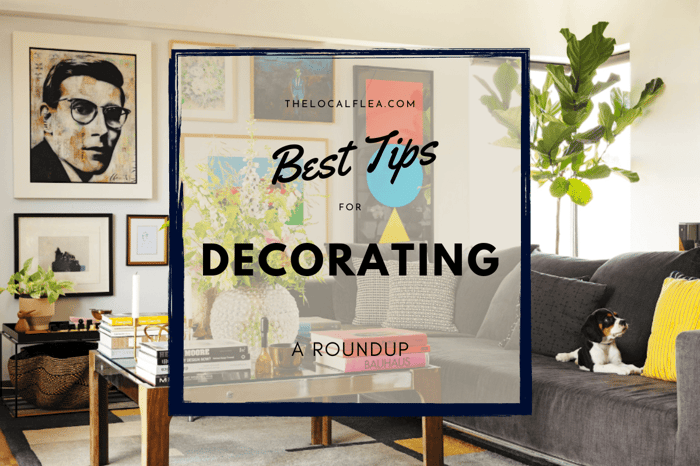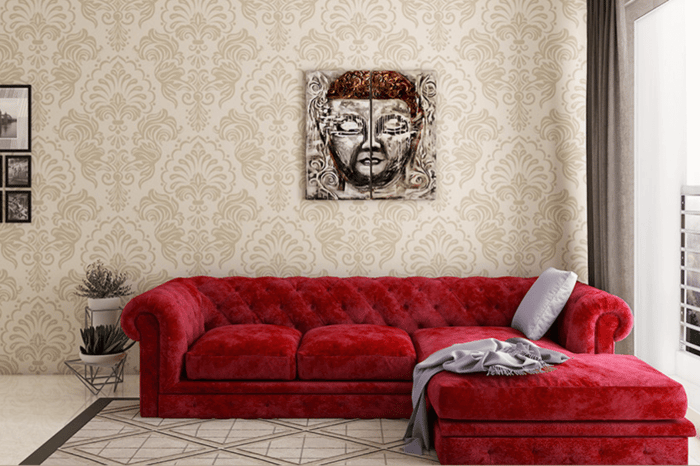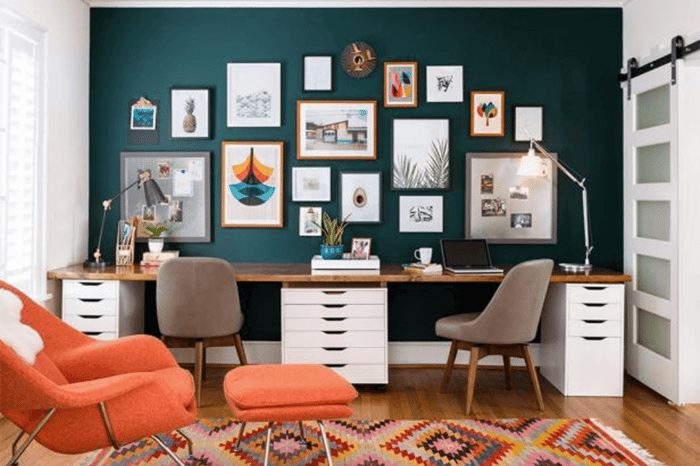Decorating your home can be fun and can also be a bit intimidating. This roundup of decorating guides offers you many great tools for all aspects of the design process. Get the best decorating tips from the experts! From working with a professional remotely to inexpensive decorating hacks to tips for furniture selection and individual room decor ideas. Remember, decor can truly make a difference in how you feel in the space you’re occupying. With some thought and planning, you can end up with a beautifully comfortable home.
- Consider how you’ll use and live in each space of the home.
- Choose a decor “theme”. There are over 50 to choose from right HERE.
- With those steps finalized, now you can benign decorating the rooms. The easiest way to start is by choosing a focal point, an area, an item, or an element in the room that immediately draws the eye to it. Every other item in the room should ideally complement this.
The following summaries of various decorating guides will walk you through every stage of your decor adventure.
Top 10 Best Tips For Decorating Roundup In Review
- Art Buying Guide
- Decorative Wall Style Guide
- Focal Points Guide
- Furniture To Stay Organized
- Furniture Trends
- How Paint Effects Room Design
- Metals: The How-To Decor Guide
- Redecorating: A Complete How-To Guide
- Restful Bedroom Tips
- Working Remotely With An Interior Designer
 BEST HOME DECORATING GUIDES: KEY TIPS
BEST HOME DECORATING GUIDES: KEY TIPS
A guide that directs you through the process of determining your artistic style and then how to choose pieces of art for each room in your home. To help determine the style of art you prefer, a visit to your local library’s art section is a great start. Browse through collections of art books and just note what appeals to you. Another fun way to explore is by visiting your local art galleries and working art studios.
- Start your art collection small by designating a gallery wall in your home or apartment.
- Office- use floating shelves or ledges to place your art providing you the freedom to rotate the items more often.
- Living room- Consider letting family members each choose something special that represents their passions and place together as an art collection.
- Powder rooms- often overlooked when considering where to place works of art in your home: the bathroom offers an ideal location as the art can be the focus of the room.
- Kitchen- Some options that might work best include bright, more fluid impressionistic landscapes; or sleek digital prints and cubist sculptures.
- Bedroom- The ideal place for quiet and introspective pieces, the bedroom calls for more calm and relaxing, or spiritual and inspirational art.

Adding a decorative wall in any room will jazz it up, create a focal point, as well as provide a place for you to express your inner Picasso. The top ideas for decorative wall decor include:
- Basket Display
- Chalkboard Wall
- Collage
- Color Blocks of Paint
- DIY Canvas Art
- Faux Paint Patterns
- Mirrors
- Paneling or Planking
- Textiles: Blanket, Quilt, Tapestry
- Wall Of Plants
Let your decorative wall be an expression of who you are. Whether that’s through blocks of geometric colors, a painted canvas, collections of precious artifacts, or your children’s artwork, let it fill your space with comfort and love.
Focal points serve the purpose of providing a resting place for your eyes. They act to create flow and direction, filling out the storyline for a room. The goal is to create a harmonious arrangement that feels welcoming. Begin the design process by choosing a focal point for the room: an art element, an architectural element, a display of collectibles, etc. Once that's chosen you can now design and use supporting elements around that point. Some of the ideas for focal points include:
- Bold color accent wall.
- Creative tile designs.
- Wall paper, especially those with added texture of 3D art.
- Fireplaces.
- Windows and the outside view.
- A gallery wall.
- An oversized art piece.
It seems like there’s never enough storage at home. A combined furniture storage piece provides options that meet both decorative and functional needs. They offer a place to display decor and store things inside. Using storage furniture to the fullest advantage will help you create a clutter-free organized home. Choosing multifunctional furniture will expand your home’s storage while creating a decluttered, stress-free environment that rejuvenates your spirit.
- This guide offers tips for the kitchen with gadgets and function pieces.
- The bedroom and storage closets.
- The home office.
- The main room of the home.
- The foyer.
And more…
There’s been an influx of new furniture and home design trends that are leading the remodeling home boom in ‘21 and ‘22. Top data was collected from trend experts and high-profile designers across the internet. The ones chosen also seem to be timeless and will last for years to come.
- JAPANDI: combining the modern flair of Scandinavian design with the timeless elegance of Japanese aesthetics featuring a neutral, earthy palette and an abundance of mood-boosting natural elements.
- BIOPHILIC DESIGN: A technical term for design and architecture that focuses on our connection to nature and bringing the outdoors into the home.
- STATEMENT VASES: vases are big and bold, with dominant shapes that bring instant attention and joy to a space.
- ECO-FRIENDLY DESIGN: Consumers are looking for sustainably made products and buying second-hand.
- HOME OFFICES: adding a home working space had become essential for most people. This translates to the addition of office type furniture into kitchens, living rooms, and kid's rooms; adding multiple workspaces has proven to allow for a more harmonious and efficient home environment.
- COMFY FURNITURE: People are longing for safety and security in all forms, even in their home furnishings. Chairs, sofas, beds, and all kinds of cocooning furniture have gained enormously in popularity.
- HOME GYMS: Adding some basic exercise equipment, a good sized TV screen, and surround sound speakers is a current furniture trend.
- GRANDMILLENNIAL STYLE: Modern-day design partnering with retro elements. Using Millennial creativity and imagination to incorporate hand-me-downs and inherited pieces, next to secondhand items and reclaimed furniture while making it all function in a modern home.
A guide on how to use paint colors to help express a room's feeling. Paint is color and color elicits emotional responses. There is much to consider when determining what color to paint a room to achieve your goal.
- Lighter, cooler colors give the illusion of receding, appearing farther away, and opening up a space.
- Darker, warmer colors create a tighter, smaller closed-in feeling in the chosen space.
- Ceiling- painting the ceiling of a room can have a dramatic effect on how the space feels. A room that is too big will transform into a cozier place if the ceiling is painted darker than the walls. A small tight space with a ceiling in a lighter shade raises the height of the room.
Shape With Paint
- Decorative Elements- to highlight attractive features such as a unique ceiling or decorative trim, paint the walls a different color than whatever feature you want to highlight.
- Eyesores- painting attractive eyesores the same color as the walls allows them to blend in and become less noticeable.
- Long Halls- a long, narrow space, can be shortened by painting the end walls a shade darker than the other walls.
- Molding- adding molding to the top and bottom of large, bare walls will break up the space; then painting a complementing but different color than the walls will shorten the feeling of the room.
- Stripes- the same rule applies here as does with clothing outfits: vertical stripes add length, a feeling of height, while horizontal stripes will make space feel longer, and wider.
- Small Homes- painting connecting rooms the same color keeps the eye moving from room to room. The feeling will come across as one larger space.
 Metals: The How-To Decor Guide
Metals: The How-To Decor Guide
Always popular in decorating because metals have the flexibility to suit any style from Hollywood to Industrial and everything in-between. The number one tip to embellishing with metals is: don’t overdo it. You want metals to work together. When mixing more than one color or style of metal, the secret is to mix warm and cool tones together. Tips for mixing metals includes:
- TEXTURE- Hammered, pattern stamped, brushed, and antiqued metals; textured metals work well with all the other metals. Combining brushed, polished, or hammered finishes creates a dynamic atmosphere.
- SPACING- Since metals are such strong statement pieces, it bodes well to space them out around the room. If clumped in one area, the effect is less attractive. Remember to start with a dominant metal color and then add one or two additional metals as accents.
- TIP: Metallic fabric or artwork with metallic paint are alternative ways to bring in the sheen and shine of metal in a more subtle way.
Metals and metallics are diverse decorating tools. The range they offer in look and feel affords you the flexibility to use them in any decor style. Warming, cooling, brightening, or bringing in a vintage vibe, mixing metals is a creative way to add depth and character to a room. Style guides from Modern to Shabby Chic will guide you in the decorating process and the use of accents as well.
 Redecorating: A Complete How-To Guide
Redecorating: A Complete How-To Guide
This guide shares many hacks on how to redecorate with what you have on hand and with what you can acquire easily and inexpensively
- Play With The Layout: Move pieces from one room to another, switching up the furnishings and their locations.
- Paint Touch-Ups: Think about adding a colored accent wall to one room. Or possibly changing the color of a room's baseboards, window, and door trim.
- Look At Lighting: Place floor lamps or table lights around the room at varying heights. Up-lighting and spotlights on corners or art pieces also add a layer of depth to a space.
- Hanging Collections: This tip is really about creating a decorative statement wall. You’ll be surprised at the difference a simple change in wall decor can have on a room's atmosphere.
- Second Hand Charm: Choosing a more eco-conscious option of purchasing items that have been gently used instead of buying new is a cost-effective way to add new items to your home as part of the redecorating process.
Inexpensive ideas to create a bedroom sanctuary, the one place you deeply relax, slow down, and recharge interruption free.
- Clear the Clutter: Organize your bedside tables and closets.
- Storage: Take advantage of inventive storage options will make this task much easier when you're organizing and designing a tidy room.
- Color: Softer tones in neutrals, whites, browns, and shades of blues are all calming and rest inducing colors.
- Scent: To create a restful bedroom, adding meaningful scents is another element in designing your oasis. A few useful tips: open windows when the weather allows, fresh air is a must; consider an essential oil lavender spray for the bed as this aroma induces relaxation.
- Bedding: Comfortable and quality bedding is a must!
- Blackout Drapes: Another important tip to make your bedroom as restful as possible, might be to install blackout drapery.
- Art: Art is inspiring, thought-provoking, emotional, and can carry you away into daydreams of wonder.
 Working Remotely With An Interior Designer
Working Remotely With An Interior Designer
Virtual design assistance is the new way to go. Come to your meetings prepared; it’s best to have a folder or such with all your thoughts and ideas gathered together. A virtual folder is even better, such as joining Pinterest and setting up some design idea pages for each room of your house. This allows you and your decorator to look at the ideas together on the web.
- TIP: Many designers these days offer their virtual clients a Design Kit, sending you a physical package that will include a space plan, fabric samples, a mood board, and a shopping checklist. When looking for your design partner, ask if they supply this type of product.
- BUDGET: Working virtually is definitely going to save you dollars on your designer fee costs. Remember to stay connected to your original goal for re-designing: are you looking for a complete remodel, or just wanting to freshen up the style of your space? Current prices range from $300 -$600 for small rooms, to flat fees around $2,500

#homedecor #interiordesign #home #interior #decor #design #homedesign #handmade #homesweethome #art #interiors #homedecoration #love #interiordecor #interiordesigner #interiorstyling #livingroom #luxury #homestyle #instagood #homeinspo #walldecor #diy #inspiration #style #furnishing #furniture #interiordesign #homedecor #interior #furnituredesign #decoration #sofa #homedesign #interiordesigner #interiorstyling #instahome #tlf #designer #desaininterior #remoov #furnituremakeover #interiorproject #homecustom #homefurnishing #instaliving #curtains #casafurnitureid #remoov #greenbusiness #ecobusiness













